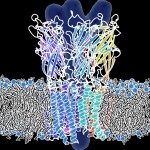Lien vers Pubmed [PMID] – 28487483
Lien vers HAL – Cliquez ici
Lien DOI – 10.1073/pnas.1617567114
Proc. Natl. Acad. Sci. U.S.A. 2017 05;114(21):E4158-E4167
Pentameric ligand-gated ion channels control synaptic neurotransmission by converting chemical signals into electrical signals. Agonist binding leads to rapid signal transduction via an allosteric mechanism, where global protein conformational changes open a pore across the nerve cell membrane. We use all-atom molecular dynamics with a swarm-based string method to solve for the minimum free-energy gating pathways of the proton-activated bacterial GLIC channel. We describe stable wetted/open and dewetted/closed states, and uncover conformational changes in the agonist-binding extracellular domain, ion-conducting transmembrane domain, and gating interface that control communication between these domains. Transition analysis is used to compute free-energy surfaces that suggest allosteric pathways; stabilization with pH; and intermediates, including states that facilitate channel closing in the presence of an agonist. We describe a switching mechanism that senses proton binding by marked reorganization of subunit interface, altering the packing of β-sheets to induce changes that lead to asynchronous pore-lining M2 helix movements. These results provide molecular details of GLIC gating and insight into the allosteric mechanisms for the superfamily of pentameric ligand-gated channels.

